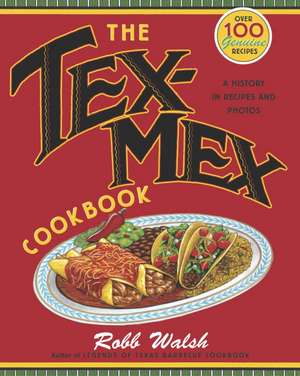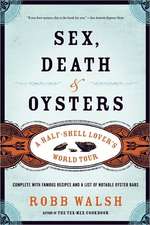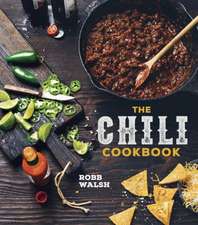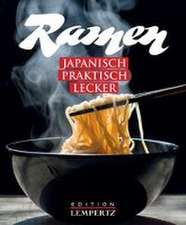The Tex-Mex Cookbook: A History in Recipes and Photos
Autor Robb Walshen Limba Engleză Paperback – 31 mai 2004
Vezi toate premiile Carte premiată
IACP Crystal Whisk Award (2005)
From the Mexican pioneers of the sixteenth century, who first brought horses and cattle to Texas, to the Spanish mission era when cumin and garlic were introduced, to the 1890s when the Chile Queens of San Antonio sold their peppery stews to gringos like O. Henry and Ambrose Bierce, and through the chili gravy, combination plates, crispy tacos, and frozen margaritas of the twentieth century, all the way to the nuevo fried oyster nachos and vegetarian chorizo of today, here is the history of Tex-Mex in more than 100 recipes and 150 photos.
Rolled, folded, and stacked enchiladas, old-fashioned puffy tacos, sizzling fajitas, truck-stop chili, frozen margaritas, Frito™ Pie, and much, much more, are all here in easy-to-follow recipes for home cooks.
The Tex-Mex Cookbook will delight chile heads, food history buffs, Mexican food fans, and anybody who has ever woken up in the middle of the night craving cheese enchiladas.
Preț: 120.82 lei
Nou
Puncte Express: 181
Preț estimativ în valută:
23.12€ • 25.11$ • 19.42£
23.12€ • 25.11$ • 19.42£
Carte disponibilă
Livrare economică 01-15 aprilie
Preluare comenzi: 021 569.72.76
Specificații
ISBN-13: 9780767914888
ISBN-10: 0767914880
Pagini: 267
Ilustrații: ILLUSTRATIONS THROUGHOUT HALFTONES; DUOTONES
Dimensiuni: 187 x 232 x 19 mm
Greutate: 0.57 kg
Editura: BROADWAY BOOKS
Locul publicării:New York, NY
ISBN-10: 0767914880
Pagini: 267
Ilustrații: ILLUSTRATIONS THROUGHOUT HALFTONES; DUOTONES
Dimensiuni: 187 x 232 x 19 mm
Greutate: 0.57 kg
Editura: BROADWAY BOOKS
Locul publicării:New York, NY
Notă biografică
Robb Walsh is the author of Legends of Texas Barbecue Cookbook, A Cowboy in the Kitchen, and Nuevo Tex-Mex. He is also the restaurant critic of the Houston Press, an occasional commentator for NPR’s Weekend Edition, and has served as the food columnist for Natural History. He has been nominated for six James Beard awards, including for last year’s Legends of Texas Barbecue, and has won twice.
Extras
INTRODUCTION
TEX MEX: THAT LOVABLE UGLY DUCKLING
Tex-mex is the ugly duckling of american regional cuisines. Since it was called Mexican food for most of its history, nobody even thought of it as American until about thirty years ago. That was when the first authoritative Mexican cookbook in the United States, Diana Kennedy's The Cuisines of Mexico, was published.
Kennedy trashed the "mixed plates" in "so-called Mexican restaurants" north of the border and encouraged readers to raise their standards. The English-born Kennedy was the wife of the late Paul Kennedy, a New York Times correspondent posted in Mexico City. She had never lived in the United States at the time of the book's publication in 1972 and evidently wasn't familiar with the Tejano culture.
Hugely popular in the United States, The Cuisines of Mexico was a breakthrough cookbook, one that could have been written only by a non-Mexican. It unified Mexican cooking by transcending Mexico's nasty class divisions and treating the food of the poor with the same respect as that of the upper classes. But while admirably egalitarian in her attitude toward the food of Mexicans, Kennedy lambasted the food of Texas-Mexicans.
In a later book, The Art of Mexican Cooking, Kennedy wrote, "Far too many people outside Mexico still think of them [Mexican foods] as an overly large platter of mixed messes, smothered with shrill tomato sauce, sour cream, and grated cheese preceded by a dish of mouth-searing sauce and greasy deep-fried chips. Although these do represent some of the basic foods of Mexico-in name only-they have been brought down to their lowest common denominator north of the border, on a par with the chop suey and chow mein of Chinese restaurants 20 years ago."
Tex-Mex entered the lexicon of the food world within a year of The Cuisines of Mexico's publication. The first time it was used in print in relation to food, according to the Oxford English Dictionary, was in this 1973 quote from the Mexico City News, an English-language newspaper: "It is a mistake to come to Mexico and not try the local cuisine. It is not the Tex-Mex cooking one is used to getting in the United States."
If you go to the library to look up Tex-Mex, you will find lots of definitions. But unfortunately they are all different. The dictionaries don't agree on whether Tex-Mex means Americanized Mexican food in general or specifically the kind from Texas.
Some food writers put San Francisco's steak burritos, San Diego's fish tacos, and Tucson's chimichangas in the Tex-Mex category. That's because they use the term Tex-Mex to mean Americanized Mexican food, regardless of its place of origin.
There is no consensus on what Tex-Mex means in Texas either. Middle-aged Anglos tend to describe it as a specific subset of the larger genre of Mexican food-one that involves yellow cheese enchiladas with chopped raw onions and chili gravy as served in San Antonio around 1955.
Why the confusion? Because for many years, the people who owned the restaurants where Tex-Mex was served refused to use the term at all. Tex-Mex was a slur. It was a euphemism for bastardized, and it was an insult that cost Mexican-Texan families who had been in the restaurant business for generations a lot of business.
Tex-Mex was still called Mexican food when its popularity began to spread beyond Texas to other parts of the country. But the biggest fans of Tex-Mex have always been west of the Mississippi. Texas-Mexican food first became popular in the Midwest in 1893, when a San Antonio chili stand was set up at the Chicago World's Fair. Chili con carne was being canned in Oklahoma and St. Louis by 1910. Cincinnati's first chili joint opened in 1922. And more chili joints sprung up across the country, becoming Depression-era havens for cheap food. Meanwhile, tamale vendors popularized another kind of Mexican food across the country. In The World on a Plate, food historian Joel Denker tells us tamales were among the most common foods on the streets of Chicago in the early 1900s and were far more popular than hamburgers.
Because of their greater familiarity with its traditions, food writers and cooking authorities from the western half of the country think of Tex-Mex more sympathetically than do their New York counterparts.
"I love Tex-Mex. I grew up on it," says Rick Bayless, author of Authentic Mexican and Mexico One Plate at a Time.
In his cookbooks, Bayless, who comes from Oklahoma, pays tribute to Tex-Mex as a distinctive regional cuisine. "When people cook from the heart, there isn't a right, or wrong, way to do it," he told me. Bayless said that when writing Authentic Mexican, his first cookbook, which was published in 1987, he wanted to include Tex-Mex as well as New Mexican and California Mexican. But his New York editor didn't share his point of view.
In Eating in America: A History (1976), the late Chicago food writer Waverly Root defines Tex-Mex as a unique regional cuisine: "Tex-Mex food might be described as native foreign food, contradictory through that term may seem. It is native, for it does not exist elsewhere; it was born on this soil. But it is foreign in that its inspiration came from an alien cuisine; that it has never merged into the mainstream of American cooking and remains alive almost solely in the region where it originated . . ."
Today, most people agree that Tex-Mex isn't really Mexican food. And for reasons I hope this book will explain, Tex-Mex has started to shed its negative connotations. In the last five years, some of the same Texas-Mexican restaurants that once shunned the term have begun to claim they invented Tex-Mex!
Meanwhile, historians are beginning to study "Tex-Mex" more seriously. As it has become more widely understood to describe an American regional cooking style, it has also begun to be used retroactively. Culinary folklorists now trace Tex-Mex cooking all the way back to the state's Native American peoples and to Juan de Onate's colonists who first brought European livestock to El Paso in 1581.
"Tex-Mex foods are a combination of Indian and Spanish cuisines, which came together to make a distinct new cuisine," writes Joe S. Graham in the Texas State Historical Society's Handbook of Texas Online.
For all these reasons, I thought this might be a good time for a Tex-Mex cookbook. For the past ten years, I have been gathering scraps that I thought might shed some light on the story of Tex-Mex cooking. From restaurants and museums, garage sales and presidential libraries, I've collected recipes, snapshots, menus, postcards, and advertisements for canned chili. And I've interviewed a bunch of colorful veterans of the Tex-Mex restaurant business. In this book, I have put those scraps together. The result is not a complete picture but a fragmented collage made up of one man's gleanings.
It's been more than thirty years since The Cuisines of Mexico was published, and many of its baroque Mexican dishes seem like museum pieces now, while at the same time, Tex-Mex has achieved worldwide popularity.
We can all thank Diana Kennedy for inadvertently granting Tex-Mex its rightful place in food history. By convincing us that Tex-Mex wasn't really Mexican food, she forced us to realize that it was something far more interesting: America's oldest regional cuisine.
***
DEFINING "TEX-MEX"
-Oxford English Dictionary: "Designating the Texan variety of something Mexican. First use in print, Time magazine, 1941 '. . . Tex-Mex Spanish, that half-English half-Spanish patois of the border . . .' "
-Merriam-Webster's Collegiate Dictionary, Tenth Edition Dictionary: "Of, relating to, or being the Mexican-American culture or cuisine existing or originating in esp. southern Texas."
-Food Lover's Companion: "A term given to food (as well as music, etc.) based on the combined cultures of Texas and Mexico."
***
TEJANO
"In Spanish, a Texan of Mexican descent is called a tejano or tejana (with a lowercase t). Hispanics in Texas identified themselves as Tejanos as early as January 1833, when leaders at Goliad used the term. Contemporary historians use the term to distinguish Mexican Texans from residents of other regions and to distinguish them from the Texians as Anglo-American Texans were called, during the period between the end of the Spanish era in 1821 to Texas Independence in 1836.
"The term 'Tejano' gained greater currency following the Chicano movement of the mid-1960s with corresponding changes in nuance and usage. It now encompasses language, literature, art, music, and cuisine. Tex-Mex is a related term that is not synonymous."
-Adán Benavides
from the Handbook of Texas Online.
***
TEX MEX: THAT LOVABLE UGLY DUCKLING
Tex-mex is the ugly duckling of american regional cuisines. Since it was called Mexican food for most of its history, nobody even thought of it as American until about thirty years ago. That was when the first authoritative Mexican cookbook in the United States, Diana Kennedy's The Cuisines of Mexico, was published.
Kennedy trashed the "mixed plates" in "so-called Mexican restaurants" north of the border and encouraged readers to raise their standards. The English-born Kennedy was the wife of the late Paul Kennedy, a New York Times correspondent posted in Mexico City. She had never lived in the United States at the time of the book's publication in 1972 and evidently wasn't familiar with the Tejano culture.
Hugely popular in the United States, The Cuisines of Mexico was a breakthrough cookbook, one that could have been written only by a non-Mexican. It unified Mexican cooking by transcending Mexico's nasty class divisions and treating the food of the poor with the same respect as that of the upper classes. But while admirably egalitarian in her attitude toward the food of Mexicans, Kennedy lambasted the food of Texas-Mexicans.
In a later book, The Art of Mexican Cooking, Kennedy wrote, "Far too many people outside Mexico still think of them [Mexican foods] as an overly large platter of mixed messes, smothered with shrill tomato sauce, sour cream, and grated cheese preceded by a dish of mouth-searing sauce and greasy deep-fried chips. Although these do represent some of the basic foods of Mexico-in name only-they have been brought down to their lowest common denominator north of the border, on a par with the chop suey and chow mein of Chinese restaurants 20 years ago."
Tex-Mex entered the lexicon of the food world within a year of The Cuisines of Mexico's publication. The first time it was used in print in relation to food, according to the Oxford English Dictionary, was in this 1973 quote from the Mexico City News, an English-language newspaper: "It is a mistake to come to Mexico and not try the local cuisine. It is not the Tex-Mex cooking one is used to getting in the United States."
If you go to the library to look up Tex-Mex, you will find lots of definitions. But unfortunately they are all different. The dictionaries don't agree on whether Tex-Mex means Americanized Mexican food in general or specifically the kind from Texas.
Some food writers put San Francisco's steak burritos, San Diego's fish tacos, and Tucson's chimichangas in the Tex-Mex category. That's because they use the term Tex-Mex to mean Americanized Mexican food, regardless of its place of origin.
There is no consensus on what Tex-Mex means in Texas either. Middle-aged Anglos tend to describe it as a specific subset of the larger genre of Mexican food-one that involves yellow cheese enchiladas with chopped raw onions and chili gravy as served in San Antonio around 1955.
Why the confusion? Because for many years, the people who owned the restaurants where Tex-Mex was served refused to use the term at all. Tex-Mex was a slur. It was a euphemism for bastardized, and it was an insult that cost Mexican-Texan families who had been in the restaurant business for generations a lot of business.
Tex-Mex was still called Mexican food when its popularity began to spread beyond Texas to other parts of the country. But the biggest fans of Tex-Mex have always been west of the Mississippi. Texas-Mexican food first became popular in the Midwest in 1893, when a San Antonio chili stand was set up at the Chicago World's Fair. Chili con carne was being canned in Oklahoma and St. Louis by 1910. Cincinnati's first chili joint opened in 1922. And more chili joints sprung up across the country, becoming Depression-era havens for cheap food. Meanwhile, tamale vendors popularized another kind of Mexican food across the country. In The World on a Plate, food historian Joel Denker tells us tamales were among the most common foods on the streets of Chicago in the early 1900s and were far more popular than hamburgers.
Because of their greater familiarity with its traditions, food writers and cooking authorities from the western half of the country think of Tex-Mex more sympathetically than do their New York counterparts.
"I love Tex-Mex. I grew up on it," says Rick Bayless, author of Authentic Mexican and Mexico One Plate at a Time.
In his cookbooks, Bayless, who comes from Oklahoma, pays tribute to Tex-Mex as a distinctive regional cuisine. "When people cook from the heart, there isn't a right, or wrong, way to do it," he told me. Bayless said that when writing Authentic Mexican, his first cookbook, which was published in 1987, he wanted to include Tex-Mex as well as New Mexican and California Mexican. But his New York editor didn't share his point of view.
In Eating in America: A History (1976), the late Chicago food writer Waverly Root defines Tex-Mex as a unique regional cuisine: "Tex-Mex food might be described as native foreign food, contradictory through that term may seem. It is native, for it does not exist elsewhere; it was born on this soil. But it is foreign in that its inspiration came from an alien cuisine; that it has never merged into the mainstream of American cooking and remains alive almost solely in the region where it originated . . ."
Today, most people agree that Tex-Mex isn't really Mexican food. And for reasons I hope this book will explain, Tex-Mex has started to shed its negative connotations. In the last five years, some of the same Texas-Mexican restaurants that once shunned the term have begun to claim they invented Tex-Mex!
Meanwhile, historians are beginning to study "Tex-Mex" more seriously. As it has become more widely understood to describe an American regional cooking style, it has also begun to be used retroactively. Culinary folklorists now trace Tex-Mex cooking all the way back to the state's Native American peoples and to Juan de Onate's colonists who first brought European livestock to El Paso in 1581.
"Tex-Mex foods are a combination of Indian and Spanish cuisines, which came together to make a distinct new cuisine," writes Joe S. Graham in the Texas State Historical Society's Handbook of Texas Online.
For all these reasons, I thought this might be a good time for a Tex-Mex cookbook. For the past ten years, I have been gathering scraps that I thought might shed some light on the story of Tex-Mex cooking. From restaurants and museums, garage sales and presidential libraries, I've collected recipes, snapshots, menus, postcards, and advertisements for canned chili. And I've interviewed a bunch of colorful veterans of the Tex-Mex restaurant business. In this book, I have put those scraps together. The result is not a complete picture but a fragmented collage made up of one man's gleanings.
It's been more than thirty years since The Cuisines of Mexico was published, and many of its baroque Mexican dishes seem like museum pieces now, while at the same time, Tex-Mex has achieved worldwide popularity.
We can all thank Diana Kennedy for inadvertently granting Tex-Mex its rightful place in food history. By convincing us that Tex-Mex wasn't really Mexican food, she forced us to realize that it was something far more interesting: America's oldest regional cuisine.
***
DEFINING "TEX-MEX"
-Oxford English Dictionary: "Designating the Texan variety of something Mexican. First use in print, Time magazine, 1941 '. . . Tex-Mex Spanish, that half-English half-Spanish patois of the border . . .' "
-Merriam-Webster's Collegiate Dictionary, Tenth Edition Dictionary: "Of, relating to, or being the Mexican-American culture or cuisine existing or originating in esp. southern Texas."
-Food Lover's Companion: "A term given to food (as well as music, etc.) based on the combined cultures of Texas and Mexico."
***
TEJANO
"In Spanish, a Texan of Mexican descent is called a tejano or tejana (with a lowercase t). Hispanics in Texas identified themselves as Tejanos as early as January 1833, when leaders at Goliad used the term. Contemporary historians use the term to distinguish Mexican Texans from residents of other regions and to distinguish them from the Texians as Anglo-American Texans were called, during the period between the end of the Spanish era in 1821 to Texas Independence in 1836.
"The term 'Tejano' gained greater currency following the Chicano movement of the mid-1960s with corresponding changes in nuance and usage. It now encompasses language, literature, art, music, and cuisine. Tex-Mex is a related term that is not synonymous."
-Adán Benavides
from the Handbook of Texas Online.
***
Descriere
After spending much of his career researching the vibrant cuisine, Walsh has compiled a comprehensive Tex-Mex bible, filled with outsize characters, fascinating stories, rare archival photographs, and of course great recipes for classic and "nuevo" dishes.
Premii
- IACP Crystal Whisk Award Nominee, 2005














